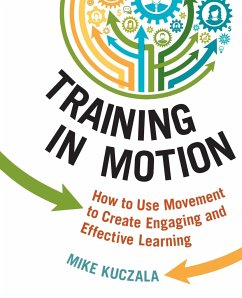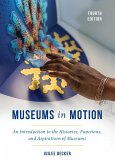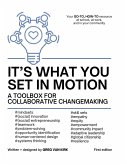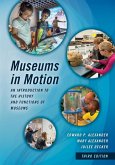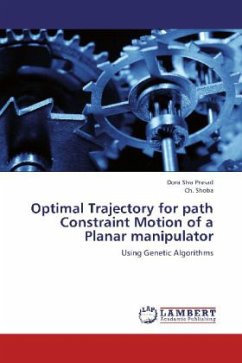- Broschiertes Buch
- Merkliste
- Auf die Merkliste
- Bewerten Bewerten
- Teilen
- Produkt teilen
- Produkterinnerung
- Produkterinnerung
Get your team moving . . . and get them learning!
Andere Kunden interessierten sich auch für
![Museums in Motion Museums in Motion]() Juilee DeckerMuseums in Motion57,99 €
Juilee DeckerMuseums in Motion57,99 €![It's What You Set In Motion It's What You Set In Motion]() Greg van KirkIt's What You Set In Motion25,99 €
Greg van KirkIt's What You Set In Motion25,99 €![Museums in Motion Museums in Motion]() Edward P. AlexanderMuseums in Motion69,99 €
Edward P. AlexanderMuseums in Motion69,99 €![MRI-Guided Prostate Motion Tracking MRI-Guided Prostate Motion Tracking]() Hadi TadayyonMRI-Guided Prostate Motion Tracking31,99 €
Hadi TadayyonMRI-Guided Prostate Motion Tracking31,99 €![Optimal Trajectory for path Constraint Motion of a Planar manipulator Optimal Trajectory for path Constraint Motion of a Planar manipulator]() Dora SIva PrasadOptimal Trajectory for path Constraint Motion of a Planar manipulator33,99 €
Dora SIva PrasadOptimal Trajectory for path Constraint Motion of a Planar manipulator33,99 €![ARPS: AN EFFICIENT FAST BLOCK MATCHING ALGORITHM FOR MOTION ESTIMATION ARPS: AN EFFICIENT FAST BLOCK MATCHING ALGORITHM FOR MOTION ESTIMATION]() Poonam KadianARPS: AN EFFICIENT FAST BLOCK MATCHING ALGORITHM FOR MOTION ESTIMATION43,99 €
Poonam KadianARPS: AN EFFICIENT FAST BLOCK MATCHING ALGORITHM FOR MOTION ESTIMATION43,99 €![Museums in Motion Museums in Motion]() Juilee DeckerMuseums in Motion130,99 €
Juilee DeckerMuseums in Motion130,99 €-
-
-
Get your team moving . . . and get them learning!
Hinweis: Dieser Artikel kann nur an eine deutsche Lieferadresse ausgeliefert werden.
Hinweis: Dieser Artikel kann nur an eine deutsche Lieferadresse ausgeliefert werden.
Produktdetails
- Produktdetails
- Verlag: AMACOM
- Seitenzahl: 224
- Erscheinungstermin: 10. Juni 2015
- Englisch
- Abmessung: 235mm x 191mm x 12mm
- Gewicht: 428g
- ISBN-13: 9780814434949
- ISBN-10: 0814434940
- Artikelnr.: 42024671
- Herstellerkennzeichnung
- Libri GmbH
- Europaallee 1
- 36244 Bad Hersfeld
- gpsr@libri.de
- Verlag: AMACOM
- Seitenzahl: 224
- Erscheinungstermin: 10. Juni 2015
- Englisch
- Abmessung: 235mm x 191mm x 12mm
- Gewicht: 428g
- ISBN-13: 9780814434949
- ISBN-10: 0814434940
- Artikelnr.: 42024671
- Herstellerkennzeichnung
- Libri GmbH
- Europaallee 1
- 36244 Bad Hersfeld
- gpsr@libri.de
MIKE KUCZALA is President of Kuczala Consulting and the Director of Instruction for the Regional Training Center, an educator development firm. He has designed or co-designed three of the most successful courses in RTC's history-all incorporating movement into training.
Contents
Foreword
Preface
Acknowledgments
SECTION 1 THE CONNECTION THAT MOVES YOU
1 Connecting Movement to a Learning Brain
Making a Connection
Brain Basics
Key Concepts
2 Training With the Brain in Mind
Why Movement Creates Engagement
Eight Brain Principles You Need to Know
Long-Term Memory
The Limits of Memory
Six Long-Term Memory Techniques
The Brain/Body Connection
Implication for Training
Key Concepts
Eight Brain Principles Worksheet
Notes
3 Applying the Benefits of Movement
Worst of Times
What Trainers Should Do
Learning That Engages
Eight Ways Movement Enhances the Training Process
Attention Span and Training
What Movement Can Accomplish
Four Purposes of Movement in Training
Decided When to Use Movement
Rest of the Story
Key Concepts
Benefits of Movement Worksheet
SECTION 2 MOVEMENT ACTIVITIES FOR TRAINING
4 Brain-Break Activities
The Goals of a Brain Break
How the Brain Works
Bridging Engagement Barriers
The Best Time to Use Brain Breaks
18 Partner Brain-Break Activities
Summary
Key Concepts
18 Brain-Break Principles Worksheet
Note
5 Team-Building Activities
Emotional Connections and Long-Term Memory
10 Team-Building Activities
Key Concepts
10 Team-Building Activities Worksheet
Notes
6 Content-Review Activities
Five Content-Review Activities
Key Concepts
Content-Review Activities Worksheet
SECTION 3 THE BIG PICTURE
7 The Kinesthetic Presenter
Sensory Experience and Nonverbal Messages
Three Key Kinesthetic Presentation Techniques
Five Hand Habits That Send the Wrong Message
What to Do With Your Hands
How to Be a Confident Kinesthetic Presenter
and Trainer
Key Concepts
Kinesthetic Presenter Principles Worksheet
Notes
8 Why Movement Is a Powerful Learning Tool
The Body Is an Efficient Learning Tool
Education and Training
Other Benefits of Movement: Corporate Wellness
Notes
APPENDIX
1 Glossary
2 Worksheets and Handouts
3 Other Resources
Index
About the Author
Foreword
Preface
Acknowledgments
SECTION 1 THE CONNECTION THAT MOVES YOU
1 Connecting Movement to a Learning Brain
Making a Connection
Brain Basics
Key Concepts
2 Training With the Brain in Mind
Why Movement Creates Engagement
Eight Brain Principles You Need to Know
Long-Term Memory
The Limits of Memory
Six Long-Term Memory Techniques
The Brain/Body Connection
Implication for Training
Key Concepts
Eight Brain Principles Worksheet
Notes
3 Applying the Benefits of Movement
Worst of Times
What Trainers Should Do
Learning That Engages
Eight Ways Movement Enhances the Training Process
Attention Span and Training
What Movement Can Accomplish
Four Purposes of Movement in Training
Decided When to Use Movement
Rest of the Story
Key Concepts
Benefits of Movement Worksheet
SECTION 2 MOVEMENT ACTIVITIES FOR TRAINING
4 Brain-Break Activities
The Goals of a Brain Break
How the Brain Works
Bridging Engagement Barriers
The Best Time to Use Brain Breaks
18 Partner Brain-Break Activities
Summary
Key Concepts
18 Brain-Break Principles Worksheet
Note
5 Team-Building Activities
Emotional Connections and Long-Term Memory
10 Team-Building Activities
Key Concepts
10 Team-Building Activities Worksheet
Notes
6 Content-Review Activities
Five Content-Review Activities
Key Concepts
Content-Review Activities Worksheet
SECTION 3 THE BIG PICTURE
7 The Kinesthetic Presenter
Sensory Experience and Nonverbal Messages
Three Key Kinesthetic Presentation Techniques
Five Hand Habits That Send the Wrong Message
What to Do With Your Hands
How to Be a Confident Kinesthetic Presenter
and Trainer
Key Concepts
Kinesthetic Presenter Principles Worksheet
Notes
8 Why Movement Is a Powerful Learning Tool
The Body Is an Efficient Learning Tool
Education and Training
Other Benefits of Movement: Corporate Wellness
Notes
APPENDIX
1 Glossary
2 Worksheets and Handouts
3 Other Resources
Index
About the Author
Contents
Foreword
Preface
Acknowledgments
SECTION 1 THE CONNECTION THAT MOVES YOU
1 Connecting Movement to a Learning Brain
Making a Connection
Brain Basics
Key Concepts
2 Training With the Brain in Mind
Why Movement Creates Engagement
Eight Brain Principles You Need to Know
Long-Term Memory
The Limits of Memory
Six Long-Term Memory Techniques
The Brain/Body Connection
Implication for Training
Key Concepts
Eight Brain Principles Worksheet
Notes
3 Applying the Benefits of Movement
Worst of Times
What Trainers Should Do
Learning That Engages
Eight Ways Movement Enhances the Training Process
Attention Span and Training
What Movement Can Accomplish
Four Purposes of Movement in Training
Decided When to Use Movement
Rest of the Story
Key Concepts
Benefits of Movement Worksheet
SECTION 2 MOVEMENT ACTIVITIES FOR TRAINING
4 Brain-Break Activities
The Goals of a Brain Break
How the Brain Works
Bridging Engagement Barriers
The Best Time to Use Brain Breaks
18 Partner Brain-Break Activities
Summary
Key Concepts
18 Brain-Break Principles Worksheet
Note
5 Team-Building Activities
Emotional Connections and Long-Term Memory
10 Team-Building Activities
Key Concepts
10 Team-Building Activities Worksheet
Notes
6 Content-Review Activities
Five Content-Review Activities
Key Concepts
Content-Review Activities Worksheet
SECTION 3 THE BIG PICTURE
7 The Kinesthetic Presenter
Sensory Experience and Nonverbal Messages
Three Key Kinesthetic Presentation Techniques
Five Hand Habits That Send the Wrong Message
What to Do With Your Hands
How to Be a Confident Kinesthetic Presenter
and Trainer
Key Concepts
Kinesthetic Presenter Principles Worksheet
Notes
8 Why Movement Is a Powerful Learning Tool
The Body Is an Efficient Learning Tool
Education and Training
Other Benefits of Movement: Corporate Wellness
Notes
APPENDIX
1 Glossary
2 Worksheets and Handouts
3 Other Resources
Index
About the Author
Foreword
Preface
Acknowledgments
SECTION 1 THE CONNECTION THAT MOVES YOU
1 Connecting Movement to a Learning Brain
Making a Connection
Brain Basics
Key Concepts
2 Training With the Brain in Mind
Why Movement Creates Engagement
Eight Brain Principles You Need to Know
Long-Term Memory
The Limits of Memory
Six Long-Term Memory Techniques
The Brain/Body Connection
Implication for Training
Key Concepts
Eight Brain Principles Worksheet
Notes
3 Applying the Benefits of Movement
Worst of Times
What Trainers Should Do
Learning That Engages
Eight Ways Movement Enhances the Training Process
Attention Span and Training
What Movement Can Accomplish
Four Purposes of Movement in Training
Decided When to Use Movement
Rest of the Story
Key Concepts
Benefits of Movement Worksheet
SECTION 2 MOVEMENT ACTIVITIES FOR TRAINING
4 Brain-Break Activities
The Goals of a Brain Break
How the Brain Works
Bridging Engagement Barriers
The Best Time to Use Brain Breaks
18 Partner Brain-Break Activities
Summary
Key Concepts
18 Brain-Break Principles Worksheet
Note
5 Team-Building Activities
Emotional Connections and Long-Term Memory
10 Team-Building Activities
Key Concepts
10 Team-Building Activities Worksheet
Notes
6 Content-Review Activities
Five Content-Review Activities
Key Concepts
Content-Review Activities Worksheet
SECTION 3 THE BIG PICTURE
7 The Kinesthetic Presenter
Sensory Experience and Nonverbal Messages
Three Key Kinesthetic Presentation Techniques
Five Hand Habits That Send the Wrong Message
What to Do With Your Hands
How to Be a Confident Kinesthetic Presenter
and Trainer
Key Concepts
Kinesthetic Presenter Principles Worksheet
Notes
8 Why Movement Is a Powerful Learning Tool
The Body Is an Efficient Learning Tool
Education and Training
Other Benefits of Movement: Corporate Wellness
Notes
APPENDIX
1 Glossary
2 Worksheets and Handouts
3 Other Resources
Index
About the Author

